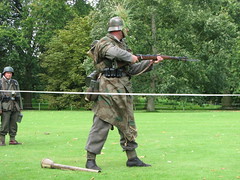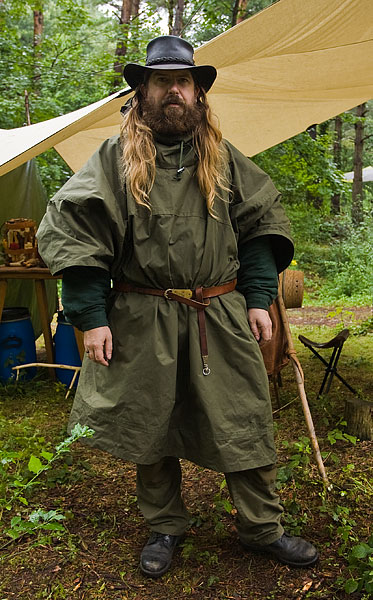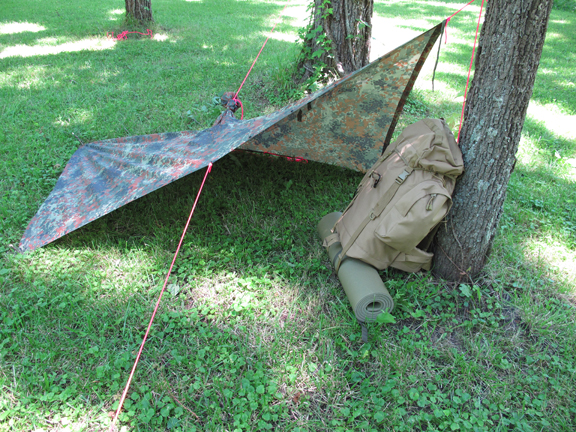
Sleeping outside in a primitive survival shelter with no tent and no sleeping bag?! In the rain? Are you crazy?
This idea may indeed seem crazy and a bit daunting to many of us. However, with a couple of hours, proper materials and the right mindset, constructing and sleeping in a primitivesurvival shelter can be a life-changing experience. Although there are many types of group and individual primitive survival shelters, at Wilderness Awareness School, we often begin by teaching our students how to build a survival shelter called a debris hut. These structures are fairly easy to construct and can be a warm, dry place to spend the night.
First of all, location is key. Aside from the normal criteria which includes avoiding low spots, steering clear of standing dead trees, etc….proximity to materials can save a lot of time and energy. Take the time to find a spot that feels right.
For construction, the first thing you’ll need to build a survival shelter is a strong ridegepole that is at least a little taller than you are with your arm stretched above your head. You’ll also need something for one end of the ridgepole to securely rest on—a stump, boulder, fork of a tree, some kind of prop. The other end rests on the ground. At the high end, the ridgepole should be at about hip height.
Once your ridgepole is in place, you’ll need ribbing. Lean the ribs against the ridgepole fairly close together leaving a door at the high end. Once ribs are in place, crawl inside feet first checking to see that you have a little room to move, but that it is still snug and cozy. If your survival shelter is too big, you will have trouble staying warm. Imagine you are making a sleeping bag out of natural materials!

Drawings by Laura
Next, add a layer of lattice, something to act as a net to hold debris in place when it is piled on next. Brush and twiggy branches may work well. The debris that you have available can help determine how small the spaces in your lattice can be.The structure is now in place and it is time for the essential component of insulation. Of all the things you’ll learn about how to build a survival shelter, not having enough insulation on a cold night will teach you quickly what is required. Get ready to shuffle your feet or makeyourself a rake and start gathering debris! For good insulation, you’ll want material that can trap air. Obviously, dry material is optimal. Pile on your leaves, ferns, grass, or other available debris.
Keep piling, keep piling, go for TWO FEET THICK or more if you might get rained on. Be sure to close up the door area so that you have just enough room to squeeze in without disturbing the structure. Crawl in to see how your cocoon feels. Finish up your insulation by adding some small branches that will hold the debris in case of wind, maintaining as much loft as possible.
Now that the outer layer is complete, it is time to stuff your primitive survival shelter with dry soft debris. If you only have wet leaves, use them anyway, you may get wet, but you can still be warm. Once your shelter is full of debris, wiggle in to compress a space for your body. Add more debris as needed, and don’t forget the foot area! Fill up the spaces if you are concerned about being cold. Before you crawl in for the night in your primitive shelter, gather a pile of leaves near the door so that you can close yourself in most of the way.
Aside from having a great story to tell your grandkids one day — or from being able to teach others how to build a survival shelter, spending a night in a survival shelter like a debris hut is an opportunity to overcome fears and gain feelings of freedom and confidence. Pushing our mental and physical comfort edges also brings us chances to find greater comfort and appreciation in our daily lives. HAPPY BUILDING AND SWEET DREAMS!
How to Build a Survival Shelter
http://www.eseeknives.com/AAO_Apr11.pdf
The debris hut is one of the fastest and easiest shelters you can make with no tools or special equipment. The concept in construction is very much like the way some animals, like squirrels, build their homes or nests. Depending upon how well it is constructed it is a very snug, warm and dry shelter good for tempratures ranging from well below -10°F to 90°F even without fire or proper clothing.
It is constructed out of debris found on the forest floor. The debris can be anything from dirt, snow, leaves, pine needles or anything that will trap insulating dead-air space. In fact, more debris = warmth, so you can never pile on too much debris. The debris forms the insulating layer that keeps the heat (your body heat) inside the structure, and so keeps you warm. Actually, the picture above is of a debris hut I made out of pine needles with Phragmite door embelishments.
As a rule where cold and/or wet conditions exits and hypothermia may be a risk, at least 24" of debris covering the top and sides is required.
Debris Hut Insulation Chart
Debris Amt. Temp.
36" (approx. 3') down to 30°F
48" (approx. 4') down to 0°F
54" (approx. 5') down to -20°F
66" (approx. 6') down to -40°F
You enter this type of shelter feet first and you may even bring in extra debris to pack around you once inside. Use debris on the floor for as a pad for sleeping and to retain body heat that can be lost by laying on the cold bare ground.
Mark your debris hut so you can find it from the outside easily. The nature of the debris hut is that it blends in perfectly with the surroundings. If someone is trying to find you they will have a hard time seeing your hut.
If you are concerned about creepy-crawlies that live in the debris or may take up residence in your hut simply smudge the inside of your debris hut out with braided sage or a leafy branch for about 15-30mins.
WARNING: Since the Debris Hut is essentially a giant tinder bundle, NEVER build a fire inside your debris hut. Make sure your fire is well away from your hut.




